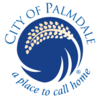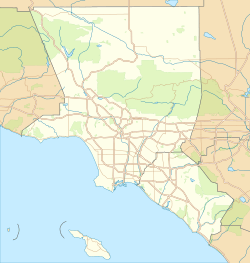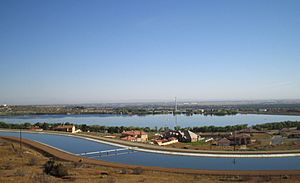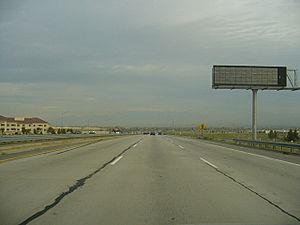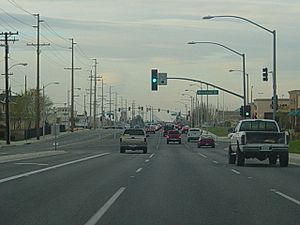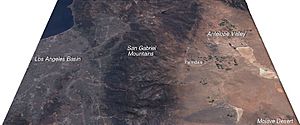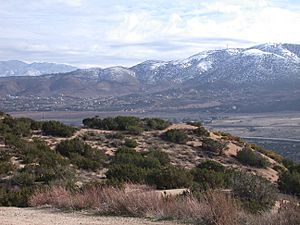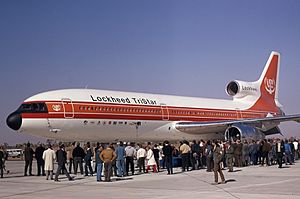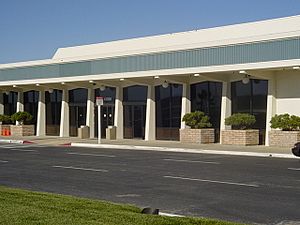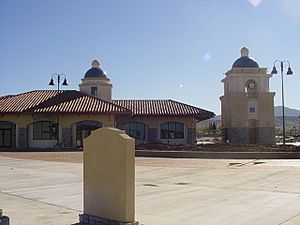Palmdale, California facts for kids
Quick facts for kids
Palmdale, California
|
|||
|---|---|---|---|
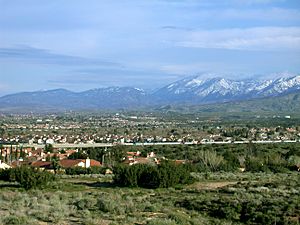
Palmdale, looking southeast toward the Antelope Valley Freeway and the San Gabriel Mountains
|
|||
|
|||
| Motto(s):
"A Place to Call Home"
|
|||
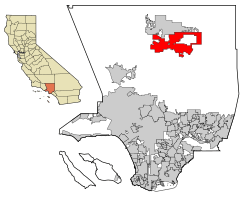
Location of Palmdale in Los Angeles County, California
|
|||
| Country | |||
| State | |||
| County | Los Angeles | ||
| Established | 1886 | ||
| Incorporated | August 24, 1962 | ||
| Named for | An anglicization of "Palmenthal", in turn named for Joshua trees, at the time referred to as "yucca palms" | ||
| Government | |||
| • Type | Council–manager | ||
| • Body | City council:
|
||
| Area | |||
| • City | 106.32 sq mi (275.37 km2) | ||
| • Land | 106.08 sq mi (274.74 km2) | ||
| • Water | 0.24 sq mi (0.63 km2) 0.24% | ||
| Elevation | 2,657 ft (810 m) | ||
| Population
(2020)
|
|||
| • City | 169,450 | ||
| • Rank | 6th in Los Angeles County 33rd in California |
||
| • Density | 1,593.77/sq mi (615.354/km2) | ||
| • Urban | 359,559 (US: 115th) | ||
| • Urban density | 4,240.9/sq mi (1,637.4/km2) | ||
| • Metro | 13,200,998 | ||
| Demonym(s) | Palmdalite | ||
| Time zone | UTC−8 (Pacific Time Zone) | ||
| • Summer (DST) | UTC−7 (PDT) | ||
| ZIP Codes |
93550–93552, 93590–93591, 93599
|
||
| Area code | 661 | ||
| FIPS code | 06-55156 | ||
| GNIS feature IDs | 1652769, 2411359 | ||
Palmdale is a city located in northern Los Angeles County, California. It sits in the Antelope Valley area of Southern California. The San Gabriel Mountains separate Palmdale from the busy Los Angeles Basin to the south.
Palmdale became the first city in the Antelope Valley on August 24, 1962. Later, in 2009, people voted for it to become a charter city. In 2020, Palmdale had a population of 169,450, making it the 33rd largest city in California. When combined with its neighbor, Lancaster, the urban area had over 359,000 people in 2020.
Contents
History of Palmdale
Palmdale was first home to different Native American groups. For about 11,000 years, the Antelope Valley was a trade route. Nomadic groups traveled through here from what is now Arizona and New Mexico to California's coast. Before Europeans arrived, the Kitanemuk people lived in the Palmdale area.
Spanish soldier Captain Pedro Fages explored the Antelope Valley in 1772. Later, in 1776, Father Francisco Garces explored the valley. He saw a large area called El Tejon Rancheria, home to the Cuabajoy Indians. After the Shoshone Indians left, new settlers from Spain and Mexico started large cattle ranches. In the late 1880s, these ranches were divided into smaller farms. Settlers from Germany, France, and Nebraska moved in to farm the land.
Palmenthal: The First Settlement (1886–1913)
The first permanent settlement in Palmdale was called "Palmenthal." It was started on April 20, 1886, by Lutheran travelers from the American Midwest. Most of these settlers were of German and Swiss descent. They thought the local Joshua trees were palm trees. So, they named their village Palmenthal, which means "Palm Valley" in German. A post office opened on June 17, 1888, making it official.
By the 1890s, more farming families came to Palmenthal. They tried to grow grain and fruit. However, they were not used to farming in a desert climate. When droughts hit, most families left their farms.
By 1899, only one family remained in the original village. The other settlers and the post office moved closer to the Southern Pacific train tracks. This new community was renamed Palmdale. A train station was built there for trains traveling between Los Angeles and San Francisco. The Wells Fargo stagecoach also stopped there.
Today, you can still see parts of the old settlements. The Palmdale Pioneer cemetery is on Avenue S and 20th Street East. The old schoolhouse is now at McAdam Park. Palmdale began to grow more after the California aqueduct was finished in 1913. This brought in many farmers.
Growth and Water Supply (1913–1933)
As Palmdale grew, water became a big problem. But on November 5, 1913, the California – Los Angeles Aqueduct was completed. This amazing system, built by William Mulholland, brought water from the Owens Valley to Los Angeles County. With more water, crops like apples, pears, and alfalfa grew well.
In 1915, Palmdale got its first newspaper, the Palmdale Post. Today, it is known as the Antelope Valley Press.
In 1921, a major road connecting Palmdale and Los Angeles was finished. It was called Mint Canyon/Lancaster Road, and later U.S. Route 6. This road helped the farming industry grow. It was an important step in making Palmdale the city it is today. This road is now called Sierra Highway.
In 1924, the Little Rock Dam and the Harold Reservoir were built. The reservoir is now called Lake Palmdale. These helped provide water for farming and the growing communities.
Aerospace Era Begins (1933–1962)
Farming was the main industry for Palmdale until World War II. In 1933, the U.S. government created Muroc Air Base, now Edwards Air Force Base, north of Lancaster. In 1952, they bought Palmdale Airport. They turned it into a place for developing and testing aircraft, called United States Air Force Plant 42.
A year later, in 1953, Lockheed opened a facility at the airport. After this, the aerospace industry became the main source of jobs. Palmdale is sometimes called the "Aerospace Capital of America." Many important military aircraft were built or tested here.
In 1957, Palmdale High School was built. This meant students no longer had to travel to Lancaster for high school.
Becoming a City (1962–1980)
In August 1962, Palmdale officially became a city. It started with about 2 square miles of land around the civic center.
In 1964, the Antelope Valley Freeway (State Highway 14) was completed. This freeway connected Palmdale to Los Angeles. By 1965, the new city had grown by another 20 square miles. Industries were doing well. Many investors bought land because they heard about a future "Palmdale Intercontinental Airport."
In 1970, the city of Los Angeles bought 17,750 acres of land east of Palmdale. This was for the proposed airport. However, the Air Force wanted to wait until the existing airport was full. So, a smaller terminal was built in 1971, creating LA/Palmdale Regional Airport. The City of Palmdale now controls this airport.
By 1974, the Antelope Valley Freeway reached the southern border of Mojave. In 1977, Palmdale built its first city building, the Palmdale City Library. That same year, Lancaster also became a city. For a long time, Lancaster had been the bigger city in the Antelope Valley.
Housing Growth and Changes (1980–1990)
The 1980s and 1990s were important for Palmdale and Lancaster. Housing became more affordable here. This led to a huge increase in population. Many people who worked in Los Angeles moved to Palmdale. In 1980, Palmdale's population was 12,227.
Geography of Palmdale
Palmdale is in Los Angeles County. The San Gabriel Mountains separate Palmdale from Los Angeles. These mountains are about 40 miles wide. They form the southern edge of the Antelope Valley, which is part of the Mojave Desert. Palmdale is the second-largest city in the Antelope Valley. It is also one of the largest cities in the Mojave Desert.
Palmdale and its northern neighbor, Lancaster, are often called "twin cities." Together, they are the main cities in the Antelope Valley and California's High Desert.
Downtown Palmdale is located at an elevation of 2,655 feet (810 meters) above sea level.
The city covers about 106.2 square miles (275.3 square kilometers). Most of this is land. About 0.3 square miles (0.63 square kilometers) is water, including Lake Palmdale.
Palmdale is close to the San Andreas Fault. This means the area can have strong earthquakes. The fault crosses the Antelope Valley Freeway just north of the Avenue S exit.
Climate in Palmdale
Palmdale has a desert climate, typical of the High Desert. Winters are cool, with temperatures often near freezing from late November to late January. December is the coolest month. Summers are hot and very dry. July and August are the hottest months.
On average, there are 52 mornings a year where the temperature is at or below freezing. There are also about 35 afternoons where the temperature reaches 100°F (38°C) or higher. The average yearly rainfall is about 5.90 inches (150 mm). Rain usually falls on only 27 days a year.
Record temperatures in Palmdale have ranged from 3°F (–16°C) in January 1963 to 118°F (48°C) in August 1990.
Plants and Animals
Many native plants grow in Palmdale. These include big berry manzanita, fremont cottonwood, California aster, White Sage, and California buckwheat. You can also find California Goldfields and California poppies growing here.
Animals in the area include the golden mantled ground squirrel and red-tailed hawk. You might also see coyotes throughout Palmdale. The California condor, a very rare bird, also lives in the Palmdale area.
Population of Palmdale
| Historical population | |||
|---|---|---|---|
| Census | Pop. | %± | |
| 1960 | 11,522 | — | |
| 1970 | 8,511 | −26.1% | |
| 1980 | 12,277 | 44.2% | |
| 1990 | 68,842 | 460.7% | |
| 2000 | 116,670 | 69.5% | |
| 2010 | 152,750 | 30.9% | |
| 2020 | 169,450 | 10.9% | |
| U.S. Decennial Census | |||
In 2020, Palmdale's population was 169,450 people. The city has grown a lot over the years. For example, in 1980, there were only 12,277 people living here.
Many different groups of people live in Palmdale. In 2020, about 61.81% of residents were Hispanic or Latino. About 16.96% were White, and 12.98% were Black or African American.
Most people in Palmdale live in family homes. The average household has about 3.55 people. About 33.1% of the population is under 18 years old. The median age in Palmdale is 29.7 years.
About 37.0% of people in Palmdale are Catholic. Overall, 53.4% of people in the city identify as religious.
In 2022, a count showed that 309 people in Palmdale were experiencing homelessness.
| Homeless population | ||
|---|---|---|
| Year | Pop. | ±% |
| 2016 | 325 | — |
| 2017 | 398 | +22.5% |
| 2018 | 203 | −49.0% |
| 2019 | 290 | +42.9% |
| 2020 | 289 | −0.3% |
| 2022 | 309 | +6.9% |
| Greater Los Angeles Homeless Count Los Angeles Homeless Services Authority |
||
Economy of Palmdale
The most important industry in Palmdale is aerospace. This means companies that design, build, and test aircraft and spacecraft. Many manufacturing companies have moved to Palmdale. They like the more affordable land and being close to Palmdale Airport.
Palmdale offers special tax breaks to companies that move there. This is because the city has an Antelope Valley Enterprise Zone and a Palmdale Federal Foreign Trade Zone. These special areas offer tax benefits and grants. They help Palmdale and Lancaster attract more jobs. This way, the cities depend less on Los Angeles for employment. It also helps reduce traffic and pollution.
Palmdale calls itself the "aerospace capital of the United States." It has been a key place for creating, testing, and fixing many famous aircraft. These include the Space Shuttle, B-1 Lancer, B-2 Spirit, and F-22 Raptor. USAF Plant 42 is home to major aerospace companies like Boeing, Lockheed Martin (with its famous Skunk Works), and Northrop Grumman.
The former Boeing hangar at Plant 42 is one of the largest buildings in the world. It was even used as a movie set for the film The Terminal. NASA's SOFIA program also operates from this hangar.
Many other companies have chosen Palmdale as their home. Delta Scientific makes strong vehicle barrier systems. US Pole makes street lighting poles. The Palmdale Trade and Commerce Center has many manufacturing and corporate offices. The Palmdale Auto Mall is also there.
In 2014, Kinkisharyo, a company that builds light-rail cars, announced plans to build vehicles in Palmdale. These cars are for the Metropolitan Transportation Authority.
The Antelope Valley Mall is the main shopping center in the region. It has many stores and restaurants.
Onions are the most valuable crop grown in Palmdale. Some onions from the Antelope Valley are sent to Japan, Taiwan, Dubai, and Australia. Other crops grown here include alfalfa, wheat, fruit, oats, and barley.
Largest Employers in Palmdale
Some of the biggest employers in Palmdale include:
- Northrop Grumman (7,000 employees)
- Lockheed Martin (3,750 employees)
- Antelope Valley Union High School District (3,089 employees)
- Palmdale School District (2,100 employees)
- Antelope Valley Mall (1,800 employees)
- Palmdale Regional Medical Center (1,200 employees)
- Walmart (800 employees)
Education in Palmdale
Palmdale has several school districts for different age groups.
Kindergarten – Grade 12 Schools
- The Palmdale School District is one of the largest elementary school districts in the country. It has 29 schools and about 28,000 students from kindergarten to 8th grade. Many schools in this district are named after desert plants and animals, like Tumbleweed and Juniper.
- The Westside Union School District serves schools on the far west side of Palmdale. It has over 8,250 students and 11 schools for K–8 education.
- The Keppel Union School District covers schools on the far east side of Palmdale. It has six schools and almost 3,000 students for K–8 education.
- The Antelope Valley Union High School District teaches most students from 9th to 12th grade in the area. It has 12 schools and over 25,000 students.
- The Palmdale Aerospace Academy is a new charter school that opened in 2012. It focuses on aerospace topics.
- Paraclete High School is a private high school that serves the Antelope Valley.
Colleges and Universities
- The Antelope Valley Community College District has a campus in Palmdale. A larger campus is in nearby Lancaster.
- The California State University system has a satellite campus in Lancaster, linked to its Bakersfield facility.
- DeVry University has a campus in Palmdale.
- Brandman University also has a campus in Palmdale.
- The AERO Institute at the Palmdale Institute of Technology offers college-level courses. It works with universities like Purdue and USC. This school specializes in aerospace science and engineering.
Media in Palmdale
Palmdale has several ways to get local news and entertainment.
Newspapers
- Antelope Valley Press
- The Antelope Valley Times
- Aerotech News and Review
Radio Stations
You can listen to many radio stations in Palmdale:
- KAVL 610 AM (Sports)
- KTPI 1340 AM (Adult Standards)
- KQAV 93.5 FM (Classic Rock)
- KTPI-FM 97.7 FM (Country)
- KKZQ 100.1 FM (Modern Rock)
- KVVS 105.5 FM (Top 40)
Television Stations
- TW Cable 3 (Local Events / News)
- Palmdale 27 (City's cable information channel)
Transportation in Palmdale
Palmdale has one of the longest average commute times in the United States. This is because many people travel to jobs in nearby Santa Clarita and Los Angeles.
Airport
The LA/Palmdale Regional Airport/Air Force Plant 42 (PMD) has two very long runways. While there isn't regular commercial airline service right now, the city is working to bring it back. Los Angeles World Airports owns a large area of land next to the airport. This land was bought to build a huge "Palmdale Intercontinental Airport" in the future.
NASA also uses facilities at Air Force Plant 42. They conduct research and operate special aircraft like the ER-2 and the 747-based SOFIA infrared telescope.
Highways
- The Antelope Valley Freeway (SR 14) is the main highway. It connects Palmdale to Los Angeles in the south and Mojave in the north.
- State Route 138 (SR 138) is an east-west highway. It connects Palmdale to the Inland Empire.
- State Route 18 (SR 18) goes east from the Antelope Valley. It connects to Victorville and is a common route to Las Vegas, Nevada.
Street System
Palmdale has a grid system for its streets. East-west roads are called avenues, and north-south roads are called streets.
- Avenues are lettered from north to south, starting with Avenue A. Each lettered avenue is about one mile apart. Smaller roads between them have numbers, like Avenue R-8.
- Streets are numbered with "East" or "West" based on their distance from Division Street. The numbers increase by 10 for each mile.
- House addresses on avenues are numbered based on the streets. For example, "2001 East Palmdale Boulevard" is just east of 20th Street East.
Avenue M is generally the border between Palmdale and Lancaster. Avenue M was recently renamed Columbia Way to honor the astronauts of the Space Shuttle Columbia. 10th Street East north of Columbia Way was renamed Challenger Way in 1987, in honor of those lost in the Challenger Disaster. All the Space Shuttles were built in Palmdale.
Public Transportation
The Palmdale Transportation Center is the main public transport hub for the Antelope Valley. It opened in 2005. It serves the Antelope Valley Transit Authority (the city's bus system). It is also a station for Amtrak, Greyhound Bus, and Metrolink commuter trains. The station is also planned to be a stop for the future California High-Speed Rail system.
Fun Places to Visit in Palmdale
- Best Of The West Softball Complex: A great place for softball games.
- Dry Town Water Park: A water park open in the summer from May to September.
- Joshua Ranch Trail: A natural area, currently closed for development.
- Palmdale Amphitheater: A large outdoor theater with 10,000 seats. It hosts concerts with famous performers in the summer.
- Joe Davies Heritage Airpark: Located at Palmdale Plant 42. You can see displays of different aircraft built or tested in Palmdale.
- Palmdale Playhouse and Art Gallery: A place for plays and art shows.
- Barrel Springs Equestrian Center: A center for horse riding.
- Palmdale Schoolhouse at McAdam Park: The only building left from the original village of Palmenthal.
- Rancho Vista Golf Course: Palmdale's only PGA-class golf course.
- Thursday Night on the Square: A fun event in the summer with an outdoor market, live music, crafts, and activities for kids.
- Antelope Valley Mall: A large shopping mall with many stores and restaurants.
Notable People from Palmdale
- Carlos Aguilar, a soccer player.
- Steve Hofbauer, a mayor.
- Joseph Edgar Foreman, a musician known as Afroman, lived in Palmdale when he was young.
Sister City
Palmdale has one sister city:
 Poncitlán, Jalisco, Mexico
Poncitlán, Jalisco, Mexico
Images for kids
See also
 In Spanish: Palmdale (California) para niños
In Spanish: Palmdale (California) para niños



